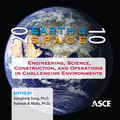Sample Return: What Happens to Samples on Earth?
Publication: Earth and Space 2010: Engineering, Science, Construction, and Operations in Challenging Environments
Abstract
As space agencies throughout the world turn their attention toward human exploration of the Moon, Mars, and the solar system beyond, there has been an increase in the number of robotic sample return missions proposed as precursors to these human endeavors. In reality, however, we, as a global community, have very little experience with robotic sample return missions: 3 of the Russian Luna Missions successfully returned lunar material in the 1970s; 28 years later, in 2004, NASA's Genesis Mission returned material from the solar wind; and in 2006, NASA's Stardust Mission returned material from the Comet Wild 2. We launch many spacecraft to LEO and return them to Earth. We also launch spacecraft beyond LEO to explore the planets, our solar system, and beyond. Some even land on these bodies. But they do not return. So as we begin to contemplate the sample return missions of the future, some common questions arise: "What really happens when the capsule returns?" "Where does it land?" "Who retrieves it and just how do they do that?" "Where does it go after that?" "How do the scientists get the samples?" "Do they keep them?" "Who decides?" The questions are nearly endless. The goal of this paper/presentation is to uncover many of the mysteries of the post-return phase of a mission with respect to the samples themselves — from the time the return body enters the atmosphere until the mission ends and the samples become part of a long term collection. The discussion is based largely on the author's own experience with NASA's Genesis and Stardust missions. Of course, these two missions have a great deal in common, being funded by the same NASA Program (Discovery), having similar team composition, and being subject to United States Laws and Regulations in addition to International Agreements. The intent, however, is to use these missions as examples in order to highlight the general requirements and the challenges in defining and meeting those requirements for the final phase of sample return missions. The choices made by the Genesis and Stardust teams regarding recovery and sample handling are discussed in comparison with the handling of returned lunar samples, the Antarctic Meteorite Collection, and the Cosmic Dust Collection at Johnson Space Center.
Get full access to this chapter
View all available purchase options and get full access to this chapter.
Information & Authors
Information
Published In
Copyright
© 2010 American Society of Civil Engineers.
History
Published online: Apr 26, 2012
Authors
Metrics & Citations
Metrics
Citations
Download citation
If you have the appropriate software installed, you can download article citation data to the citation manager of your choice. Simply select your manager software from the list below and click Download.
